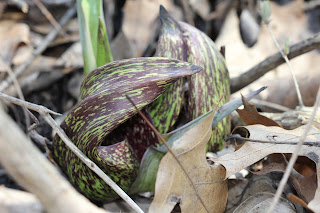 |
| Skunk Cabbage on the March 20, 2012 |
 The arrival of the skunk cabbages in a more normal winter March month, would be more interesting but not less exciting as finding them today. The skunk cabbages have intrigued biologist for centuries. They are able to produce their own heat, thus melting the snow around them. This heat keeps flower buds from freezing as the temperatures fluctuate. They also release a musky scent that attracts otherwise carrion eating insects. They have been nicknamed `beetle hotels`. Evolving for centuries with the beetle, flies and bees, who use the 72 degrees heat within the flower to stay warm, these members of the Araceae family, or thermogenic plants, including Dutchman's pipes, waterlilies, lotuses, palms and the cycads, offer a cozy environment to the otherwise freezing temps. The insects survive in these cooler, sometimes down right freezing spring changing temperatures, and use little of their own energy to stay warm.
The arrival of the skunk cabbages in a more normal winter March month, would be more interesting but not less exciting as finding them today. The skunk cabbages have intrigued biologist for centuries. They are able to produce their own heat, thus melting the snow around them. This heat keeps flower buds from freezing as the temperatures fluctuate. They also release a musky scent that attracts otherwise carrion eating insects. They have been nicknamed `beetle hotels`. Evolving for centuries with the beetle, flies and bees, who use the 72 degrees heat within the flower to stay warm, these members of the Araceae family, or thermogenic plants, including Dutchman's pipes, waterlilies, lotuses, palms and the cycads, offer a cozy environment to the otherwise freezing temps. The insects survive in these cooler, sometimes down right freezing spring changing temperatures, and use little of their own energy to stay warm. The flowers need to be cross-pollinated, because the female parts mature before the male parts release the pollen. As the heat seeking insects crawl around laying their eggs, they dutifully spread the pollen fertilizing the plant. Once fertilized the cycle is renewed for another year of this heat
producing plant.
After fertilization, the skunk cabbage unfurls it paddle shaped leaves. Colors on the leaves range from a limey green to purplish-brown streaked with green or yellow. Skunk Cabbages need to keep their feet wet, they also need acidic rich soil. The wetlands in Oakland Count offer such a habitat for the plant.
Don't be fooled by the beauty of this plant. This plant is a second-best favorite to bears, (not in Oakland County) but to humans the poisonous oxalate crystals that are in the leaves can cause blisters, to the tongue and cause burning to the digestive tract. The Native Americans, historically, used the roots of the plants to treat seizures, asthma.
In August, when other plants are showing a gorgeous fall color, our cabbage has gray-brown spheres, looking like a darning egg. The leaves are turning to slime and are rotting. The seeds are fully germinated and are either dropping near the mother plant or have been eaten and carried away by an animal or bird. These plants have survived for hundred of years, and are another reason for protecting the wetlands so quickly being replaced by Phragmites.

No comments:
Post a Comment